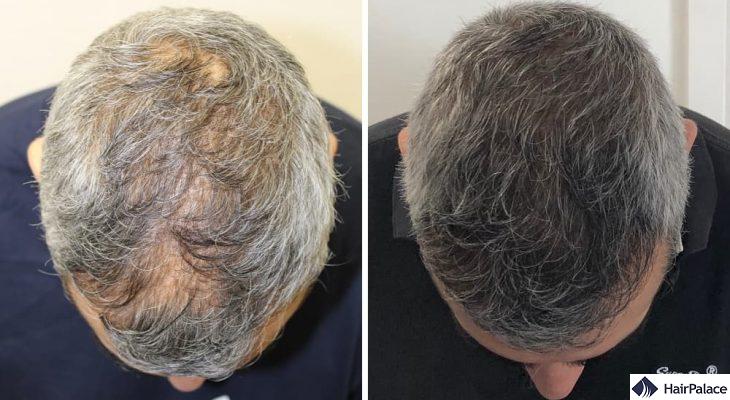Hair Transplant For Density: Check Out A Real Example

Getting a hair transplant for density is one of the most common reasons patients seek out our clinic.
See Ezra’s example to find out what a low density hair transplant can achieve.
What is hair density?
Hair density refers to the number of hair strands per square inch on the scalp.
It’s a measure of how thick or thin someone’s hair appears.
Unlike hair thickness, which pertains to the diameter of each hair strand, hair density is about the overall quantity of strands.
High hair density means there are more hair strands packed closely together, leading to fuller-looking hair.
Conversely, low hair density means fewer hair strands are present, which can make the hair appear thinner or sparser.
The ordinary hair density varies widely among individuals due to factors like genetics, age, health, and ethnicity.
It’s an important consideration in hairstyling, haircuts, and hair care routines, as different densities might require different approaches for styling and maintenance to achieve the best look and health for the hair.
How to increase hair density?
Ezra got in touch with our clinic on the 21st of September 2017 to get a hair transplant to increase density and regain his self-esteem.
During our first contact, he booked an appointment for a consultation for the 11th of October. Ezra’s main issue was the loss of density behind the hairline, affecting all three zones.
While his case was not severe, considering the size of the area the doctor found that 5000 hairs would be necessary to restore low density hair:

Due to his commitments, he could book his surgery for January 2018.
On the 12-13th of January Ezra had a high-density hair transplant with 5057 hairs using the FUE2 Safe System method.
The surgeon had to consider his original density while taking care of the original hairs in the recipient area.
In this case, the surgeon implanted 2755 hairs to strengthen the existing hairline at the front.
The remaining 2302 hairs were transplanted to the mid-scalp reaching a bit into the crown area to increase hair density:

The first few days after the surgery are crucial.
For this reason, there are a couple of rules to observe and patients must take antibiotics during the first post-op week to prevent any inflammation.
By the end of the week the tiny wounds close up, so the patients can start to soak the scabs off:

After the scabs are gone, some redness might remain. It fades away gradually, its duration depends on the sensitivity of the skin.
Starting from the 4th post-op week the vast majority of the transplanted hairs fall out.
As a result, by the end of the 3rd post-op month, the condition will return to as it was before the procedure.
There is no need to worry at this point – the implanted roots remain in place and they start to grow new hairs around the end of the 3rd post-op month!
Hair density after hair transplant

From the 4th post-op month, the new hair growth begins, and the density of the implanted area starts progressing gradually.
On the 6-month check-up photos, the hairline is more prominent and the density is much more even.
The scalp peaks through here and there, but the condition is completely normal, as this is only the halfway mark:

There are individual differences in the speed of the progress, but in general, the final result is visible 12 months after the hair transplant.
The progress was exemplary in Ezra’s case; on the final, 1-year check-up photo a high and even density is visible all over the scalp.
With the FUE2 SafeSystem method and the proper aftercare, you can achieve exceptional hair density transplant results too!

FAQ
Hair density refers to the number of hair strands per square inch on the scalp, indicating how thick or thin the hair looks.
Last medically reviewed on March 17th, 2025


